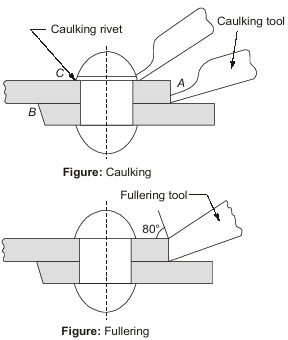Caulking and Fullering
Important Terms Used in Riveted Joint
- Pitch: It is the distance from the centre of one rivet to the centre of the next rivet measured parallel to the seam.
- Back Pitch: It is perpendicular distance between the centre lines of the successive rows.
- Diagonal Pitch: It is the distance between the centres of rivets in adjacent rows of zig-zag riveted joint.
- Margin and Marginal Pitch: It is the distance between the centre of rivet hole to the nearest edge of the plate.
Caulking and Fullering
In order to make the joints leak proof or fluid tight in pressure vessels like steam boilers, air receivers and tanks etc. a process known as caulking is employed. In this process a narrow blunt tool called caulking tool is used. Firstly edges of plate in lap joint and edges of strap plate in butt joint are beveled to 70° to 75° and then tool is hammared on edge.
A more satisfactory way of making the joints staunch is known as fullering which has largely super sided caulking. In this case a fullering tool with a thickness at the end equal to that of the plate is used in such a way that the greatest pressure due to the blows occur near the joint, giving a clean finish with less risk of damaging the plate.


